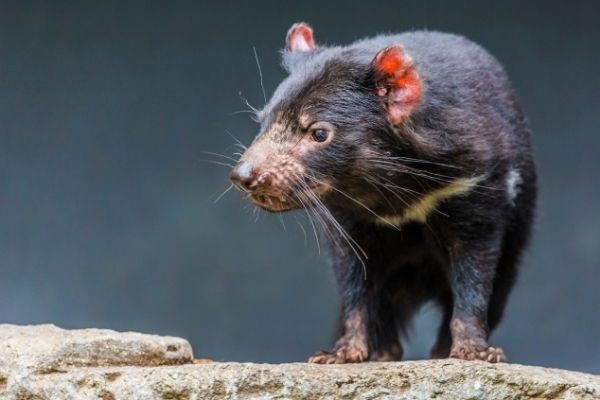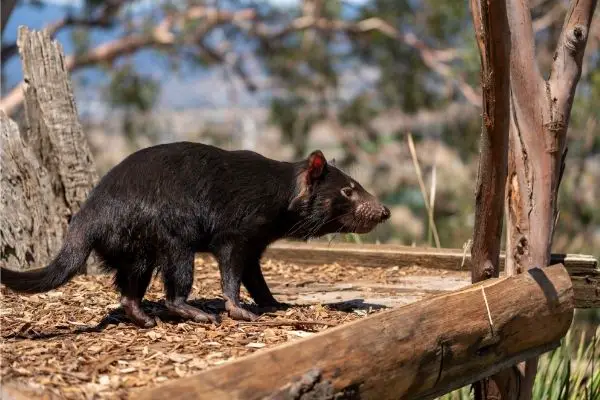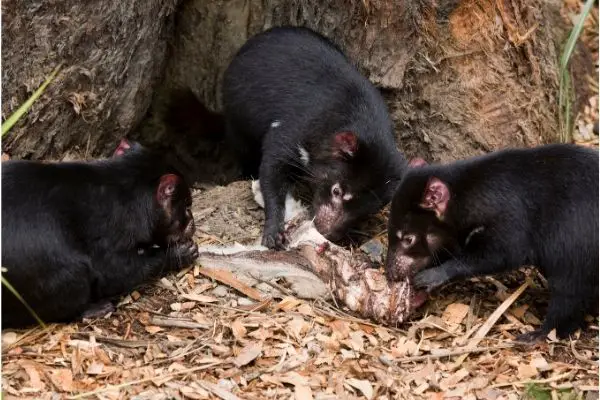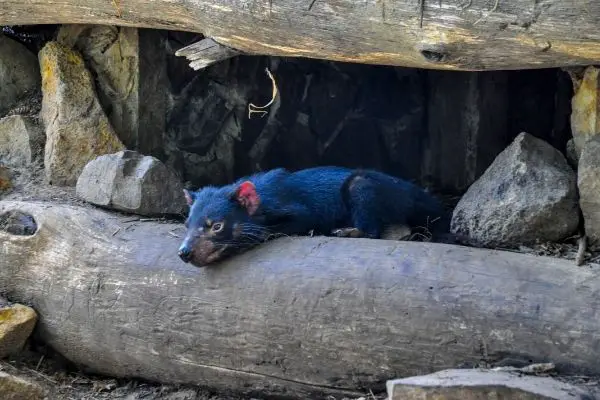We have listed down complete Tasmanian Devil Facts for Kids that will help you in learning all about the Tasmanian Devil. You are going to learn about its scientific name & classification, evolution, appearance, physical features, physical abilities, diet, habitat, lifespan, reproduction, babies, behavior, adaptations, food chain, ecological role, endangerment, population, predators, and many other interesting facts about Tasmanian Devil.
Tasmanian Devil Facts For Kids
What Is A Tasmanian Devil
- The Tasmanian devil is a small dog size carnivorous marsupial (pouched mammal).
- It is indigenous to the island state of Tasmania (Australia) and found in the wild only there.
- After the extinction of the thylacine in 1936, the Tasmanian devil is now considered the world’s largest living carnivorous marsupial.
- Tasmanian devils have a large head and neck, black fur, and stocky build.
- They are well-known for their powerful bites.
- The IUCN Red List listed the species as Endangered.
Scientific Name Of Tasmanian Devil
- The scientific name of the Tasmanian devil is Sarcophilus harrisii.
Scientific Classification Of Tasmanian Devil
The following is the scientific classification or taxonomy of the Tasmanian devil:
| Kingdom | Animalia |
| Phylum | Chordata |
| Subphylum | Vertebrata |
| Class | Mammalia |
| Infra-class | Marsupialia |
| Order | Dasyuromorphia |
| Family | Dasyuridae |
| Genus | Sarcophilus |
| Species | Sarcophilus harrisii |
Evolution Of Tasmanian Devil
- It is believed that the roots of Australian marsupials date back to tens of millions of years ago when many regions of the current Southern Hemisphere were part of Gondwana (a supercontinent).
- They migrated across Antarctica and evolved as the climate of Australia became more temperate and arid.
- It has been theorized that the emergence of the specific lineage of the Tasmanian devil occurred during the Miocene.
- Molecular evidence suggests that the ancestors of the devil are split from the quoll’s ancestors between 10 and 15 million years ago.
- At Naracoorte (South Australia), fossil deposits excavated in limestone caves date back to the Miocene. It includes specimens of S. laniarius that were about 50% heavier and 15% bigger than modern devils.
- It is unknown whether the modern devils co-existed at the time or whether they evolved from S. laniarius
- The closest relative of the devil was thylacine, which became extinct in 1936.
What Does Tasmanian Devil Look Like
Appearance
- The Tasmanian devil has a thick and stocky build, a big head, and a long tail.
- Unlike other marsupials, the devils have slightly longer forelegs than their hind legs.
- Their neck and forebody are larger than their hind body, which gives them exceptional strength. However, this feature is also a reason for their lopsided gait and squat sitting posture.
- On the forefeet, they have five toes of which four point in the front direction while one points out from the side. Their hind feet have four toes.
- Their claws are non-retractable.
- Devils have long whiskers on the face and hair clusters on the top head. They have big jaws and small rounded ears at the top of their head.
- Devils have prominent canine teeth and cheek teeth. They have four pairs of upper incisors and three pairs of lower incisors. They have 42 teeth like dogs. However, their teeth continuously grow at a slow rate throughout their life and do not replace after birth.
Color
- Tasmanian devils usually have black color fur. They have white patches on the rump and chest. However, about 16% of devils in the wild do not have white patches.
Physical Features Of Tasmanian Devil
Height
- Tasmanian devils have 20 to 31 inches in height.
Length
- The Tasmanian devil is a sexually dimorphic species and the males have a larger body size than females.
- Males have an average of 25.7 inches (2.14 feet) head and body length, and 10.2 inches (0.85 feet) tail.
- The average head and body length of females is 22.0 inches (1.83 feet), and have 9.6 inches (0.8 feet) tail.
Weight
- The average body weight of male Tasmanian devils is 8 kg (18 pounds).
- While the average body weight of females is 6 kg (13 pounds).
Physical Abilities Of Tasmanian Devil
Speed
- Tasmanian devils can run at the speed of 13 km/h (1.8 mph). However, they sustain this speed for only short distances.
Climb
- Yong Tasmanian devils can climb trees.
- Their long claws allow them to climb efficiently.
- However, they gradually lose their climbing ability as they grow to maturity.
Swim
- Tasmanian devils swim and cross about 50 meters wide rivers and icy waterways.
- Their swimming speed is unknown.
What Do Tasmanian Devils Eat
Diet
-
In Wild
-
- In the wild, Tasmanian devils mostly eat carrion and hunt live prey only if they get an opportunity.
- The most favorite prey of devils is the wombat because of its high-fat content and easy hunting.
- They also eat a variety of small mammals, fish, amphibians, reptiles, insects, and vegetable matter.
- They also prey on water rats in the sea.
- They are known to eat dead fish that have been washed ashore.
- Devils also dig the ground to eat corpses. In one case, they dig down the corpse of a buried horse that died of illness.
- They are known to first eat the softer parts of the animals (the digestive system) that result in a cavity. They then often reside in the cavity while eating other body parts.
- They are voracious and consume every part of the prey, including fur, organs, and bones.
- Devils have a very fast digestion rate and the food takes only a few hours to pass through their small gut.
-
In Captivity
-
- Tasmanian devils are fed with rats, mice, fish, and thawed rabbits at the San Diego National Zoo.
- Their diet is also supplemented with cow bones to chew.
List Of Food Items
The following are some of the food items that devils eat:
- Carrion
- Wombats
- Pademelons
- Bettong or Potoroos
- Domestic mammals
- Fish
- Birds
- Reptiles
- Frogs
- Tadpoles
- Insects
- Fruits
- Vegetable matter
How Much Tasmanian Devil Eat Per Day
- Tasmanian devils eat the average amount of food every day equal to about 15% of their whole body weight.
- However, if they get the opportunity, they can eat up to 40% of their body weight in only 30 minutes.
What Do Baby Tasmanian Devil Eat
- Baby Tasmanian devils consume mother’s milk for the initial months of their life.
- Juvenile devils eat small vertebrates and invertebrates.
- However, they also eat grubs and birds’ eggs, for which they sometimes climb trees. They are also known for climbing into nests and catching birds.
Where Do Tasmanian Devils Live – Tasmanian Devil Habitat
Natural Habitat
- Tasmanian devils were once found throughout mainland Australia. However, they are now found only on Tasmania Island in the wild. They have also been introduced in New South Wales, where they are found in small populations.
- They are found in all habitats, including the outer parts of the urban areas, the agricultural areas, woodlands, eucalyptus forests, and the coastal scrublands.
- They spend their days in dens that would be old wombat burrows, hollow logs, caves, bushes, or under stones. Former wombat burrows are especially favored as maternity dens due to their security.
- They regularly use three or four dens. They change a den after every 1 to 3 days and travel an average distance of 8.6 km (5.3 miles) every night. They sometimes travel as much as 16 km (10 miles) in a single night in search of food.
- Devils occupy a home range with an average area of 13 km² (3,200 acres). However, it will be between 4 to 27 km² (990 to 6,670 acres).
Biome
- Tasmanian devils are found in many biomes, including grassland or savannah, woodlands, forests, rainforests, scrub forests, and coastal biomes.
Range
- The current habitat range of Tasmanian devils covers the entire Island State of Tasmania. However, they are partial to forests and coastal scrublands.
Countries List
- Tasmanian devils are found only in the Australian island state of Tasmania.
Tasmanian Devil Lifespan
In Wild
- In the wild, Tasmanian devils live for an average lifespan of up to 5 years.
In Captivity
- The lifespan of Tasmanian devils in captivity is 5 to 8 years.
Tasmanian Devil Life Cycle
- The lifecycle of a Tasmanian devil starts when it is born after a gestation period of 21 days.
- It spends up to 100 days in the mother’s pouch to get nourishment and to attain further development.
- After leaving the pouch, it stays in the den for the next three months with its mother, after which it becomes independent.
- Female devils attain sexual maturity usually in their second year.
- She then starts to breed and produce her offspring.
- Devils live for a maximum age of 5 years in the wild and 8 years in captivity.
Tasmanian Devil Reproduction
- Female Tasmanian devils become fertile only once a year and produce many ova.
- Males usually compete for breeding females. Male and female devils are not monogamous and do not develop long-term relationships.
- They mate in March or April. However, recent studies show that their mating season is between February and June.
- Males usually guard their mates and keep them in custody in the den or take them along if they need to go outside.
- A litter of 20 to 30 babies is born after a gestation period of 21 days.
- As the pouch of the mother has only 4 nipples, so only 4 babies get the opportunity to reach the pouch and survive.
- If the mother is older, less than 4 babies will reside in her pouch.
- Like other marsupials, devils also give birth to underdeveloped babies.
- Mothers feed the babies with their milk in the pouch. The milk of devils has a higher amount of iron than the milk of placental mammals.
- Males produce an average number of 16 offspring while females produce 12 (in an average number of 4 mating seasons) over their lifetime.
- The pregnancy rate of devils is high and about 80% of two years old females were observed with babies in their pouches during the breeding season.
Tasmanian Devil Baby
- Baby Tasmanian devils are called joeys, pups, or imps.
- They are born undeveloped and have the size of a raisin.
- At birth, they weigh about 0.18 to 0.24 grams.
- They have well-developed digits and claws of the front limbs at birth.
- The bodies have pink color skin and their eyes are just spots.
- They have no external ears or ear openings.
- The sex of newborns can be determined, as the males have external scrotum at birth.
- The newborns compete hard to reach the pouch.
- Once inside the pouch, the baby devil attaches itself to a nipple and remains attached for the next 100 days.
- The nourishing joey quickly develops inside the pouch.
- Its external ears become visible at 15 days, the eyelids at 16 days, and the whiskers at 17 days, while its lips become visible at 20 days.
- The fur starts to grow at 49 days and the joeys have a full coat of fur at 90 days. Before the growth of fur, the skin color of the bare joeys becomes dark and dark grey or black in the tail. The process of fur growth begins from the snout and proceeds back. However, fur at the tail grows before the rump.
- The babies start making squeaking sounds after 8 weeks and can open their lips after about 10 to 11 weeks.
- Their eyelashes form at about 50 days. While the joeys have completely formed eyelids, they still can not open their eyes for three months.
- Their eyes open between 87 and 93 days, shortly after the development of the complete fur coat.
- After 105 days of their birth, the joeys leave the pouch and seem like a small version of the parents. At this time, they weigh about 200 grams.
- After leaving the pouch, the joeys stay in the den for another 3 months. During this time, they continue to feed with the mother milk.
- Between October and December, they start venturing outside the den.
- They are completely independent in January.
- The mortality rate of the joeys is very high and up to 60% of them do not survive to maturity.
Behavior Of Tasmanian Devil
- Tasmanian devils are nocturnal and remain active at night. They spend their days in hollow logs, burrows, or caves.
- The devil is a solitary animal and usually stays as well as hunts alone. However, there are some claims of communal hunting, in which one devil runs prey out of its habitat and a companion attacks. For them, eating is a social event.
- Devils make raucous noise while eating together. Their noise can be heard several kilometers away. They make this noise to inform other devils to share the food so that the food is not wasted. That is why the amount of noise they make is correlated to the carcass’s size.
- To defecate, devils return to the same place. They use a communal location to defecate, which is known as a devil latrine. Communal defecation is believed to be a way of communication, however, it is not well understood.
- Along with vocalizations, Tasmanian devils also use physical gestures to communicate, such as yawning and raising their tails.
- Devils are generally believed to be non-territorial. However, females have their territories around their dens.
Tasmanian Devil Adaptations
The following are the major structural and physiological adaptations of the Tasmanian devil:
Physical OR Structural Adaptations
-
Dark Fur
-
- Tasmanian devils have black fur.
- As they are nocturnal, their black fur blends in with the dark of the night and provides them camouflage.
-
Strong Jaws
-
- Devils have exceptionally strong and large jaws, which can open to 75 to 80 degrees.
- It allows them to exert a large amount of pressure to tear meat apart and crush bones.
- Their bite force is 553 N (56.4 kgf), sufficient to bite through a thick metal wire.
-
Long Claws
-
- Devils have long claws, which allows them to dig burrows and find underground prey easily.
- Long claws also allow them a strong grip on the prey and mates.
-
Long Whiskers
-
- Devils have long whiskers, which help them to locate food and prey in the dark.
- It also helps them to locate other devils when they are close during feeding.
-
Fat Tail
-
- Devils store their body fats in their tails. Healthy and well-developed devils have fat tails.
- Their tail is important for their locomotion.
- It provides them stability and acts as a counterbalance when they are moving quickly.
-
Five Toes On The Forefeet
-
- The forefeet of devils have five toes; four pointing in the front direction while the fifth pointing out from the side.
- Five toes make them capable of holding food.
-
Climbing Ability Of Young Devils
-
- Young devils can climb trees up to a height of about 2.5 to 3 meters.
- Climbing becomes extremely difficult for them as they grow into adults.
- This ability is considered as an adaptation for youngs to escape because extremely hungry adults may eat them.
Physiological Adaptations
-
Keen Sense Of Smell
-
- Devils have an extremely keen sense of smell.
- They can smell food, prey, and other devils at the range of 1 kilometer (0.6 miles).
-
Sense Of Hearing
-
- Tasmanian devils have an excellent sense of hearing.
- It helps them to locate hidden or underground prey, to avoid predators, and to communicate with other devils.
-
Black And White Vision
-
- Devils have a strong black and white vision, which is an important adaptation for their nocturnal lifestyle.
- It allows them to see prey and other things in dim light.
-
Scent Gland
-
- Devils have anogenital scent glands at the base of their tails.
- This gland produces a strong pungent smell, which is used to mark the ground.
- They also produce this smell as a defense mechanism when they feel threatened.
Tasmanian Devil Food Chain
- In the food chain of the Tasmanian devil, Sun is the overall source of energy.
- Plants are the producers and get energy from the sun and prepare their food themselves.
- Primary consumers are the many small and large animal species that consume plant matter as a primary source of their diet.
- Tasmanian devil is a scavenger and mainly eats carrion, however, it also preys on many small animal species and is a secondary consumer in the food chain.
- Tertiary consumers are the predators of devils, which include eagles, owls, spotted-tail quolls, and dingoes.
Ecological Role Of Tasmanian Devil
- Tasmanian devil is a keystone species in the ecosystem of Tasmania.
- They are mainly scavengers and eat carrion. Road kills and other already dead animals are a major part of their diet. They eat the carcass of an animal in minutes that would otherwise take months to decompose. In this way, they clean the forest and are often described as the vacuum cleaners of the forest.
- Tasmanian devils are also predators of many animal species that are pests for agriculture, such as rodents. Farmers often praise them as they are the natural cleaners of the pests from their farms.
Population Of Tasmanian Devil
- It is difficult to estimate the exact population size of the Tasmanian devils.
- In 2008, the Department of Primary Industries and Water of Tasmania estimated the population of devils as 10,000 to 100,000 individuals. In this population, the number of mature individuals was possibly 20,000 to 50,000.
- Experts say that the population of devils declined more than 80% since the 1990s and only about 10,000 to 15,000 individuals remained in the wild as of 2008.
Tasmanian Devil Endangerment
Reasons
- The major reasons for the Tasmanian devil’s endangerment are;
- Human activities, such as excessive road traffic are a threat to devils’ survival. They were also eradicated in the 1800s, as they were considered pests that kill livestock. However, in 1941, they were protected by law after which their population increased steadily.
- A catastrophic disease, known as devil facial tumor disease (DFTD), is cancer that causes the formation of large lumps around the mouth and head of the devil. As a result, the animal could not eat and died of starvation. This disease caused the death of thousands of devils, due to which the animal is listed as endangered.
Conservation Status
- The conservation status of the Tasmanian devil on the IUCN Red List as Endangered.
Tasmanian Devil Predators
- Tasmanian devils have few natural predators, as they are equipped with strong jaws and claws to defend themselves from predators.
- Their nocturnal lifestyle also provides them protection against predators.
- The Tasmanian wolf sometimes preys on them.
- Young devils are vulnerable and often fall prey to owls (Strigiformes), eagles, and spotted tail quolls.
Fun Facts About Tasmanian Devil
- After the extinction of the thylacine in 1936, Tasmanian devils are now the largest living carnivorous marsupials in the world.
- As Tasmanian devils mainly eat carrions, they are also described as the vacuum cleaners of the forest.
- The jaws of devils exert a force of 553 N (56.4 kgf), which is sufficient to crush bones and bite through a thick metal wire.
- Relative to their body size, devils are believed to have the most powerful bite of all the living carnivore mammals.
- Devils’ jaws and teeth resemble those of hyenas. They also have nosy scavenging habits like hyenas, that is why devils are also called Australian hyenas.
- Their teeth and claws allow them to attack wombats that are five times heavier than their body weight.
- A mother Tasmanian devil gives birth to 20 to 30 babies. However, only 4 of them get the opportunity to reach the mother’s pouch for nourishment.
- Like other marsupials, the devil’s babies are also born in the under-developed stage and their further development takes place in the mother’s pouch.
- At birth, a baby Tasmanian devil has the size of a raisin and weighs only about 0.18 to 0.24 grams.
- Like other marsupials, devils store fats in their tail. A well-fed and healthy devil has a swell and fat tail.
FAQs:
What Eats A Tasmanian Devil?
- Tasmanian wolves sometimes eat adult Tasmanian devils.
- Eagles, owls, and spotted tail quolls eat young devils.
How Dangerous Is A Tasmanian Devil?
- Devils are not dangerous. They usually avoid people and do not attack but rather escape.
- However, they will protect themselves if threatened or trapped.
Why Is The Tasmanian Devil Called A Devil?
- The name Tasmanian devil was given to the animal by the first European settlers.
- When they entered Tasmania, they heard the mysterious and unearthly screams and growls that were coming from the deep bushes. That is why they called the animal a “devil”.
How Strong Is A Tasmanian Devil Bite?
- The bite of the Tasmanian devil is considered the most powerful of all the living carnivore mammals relative to its body size.
- Its bite force is 553 N (56.4 kgf), which is sufficient to cut a thick metal wire.
Why Are Tasmanian Devils So Aggressive?
- Limited food resources and higher competition for mates make the devils so aggressive.
- They emit horrific screams and nip at the faces of one another while eating. Their mating process is also extremely violent.
Why Do Tasmanian Devils Ears Turn Red?
- During a dispute, the skin of devils becomes flush red while their ears become crimson.
- Extreme aggressiveness and stress possibly turn their ears red.
Article Short Summary
- The Tasmanian devil is a small carnivorous marsupial indigenous to the island state of Tasmania.
- It has a stocky build and is well known for its strong jaws and powerful bite. The bite force of the devil is 553 N (56.4 kgf).
- The Tasmanian devil is considered the world’s largest carnivorous marsupial after the extinction of the thylacine in 1936.
- Tasmanian devils mainly eat carrion. However, they also hunt other small animals. For their carrion diet and nosy scavenging habits, they are also sometimes described as the vacuum cleaners of the forest.
- They reproduce only once a year and give birth to 20 to 30 underdeveloped babies. The female’s pouch has only 4 nipples, so only 4 babies get the opportunity to reside in the pouch and survive.
- Devils are solitary and nocturnal.
- Due to a catastrophic disease, known as devil facial tumor disease (DFTD), a huge decline occurred in the population of devils. That is why the IUCN Red List listed the species as Endangered.
















